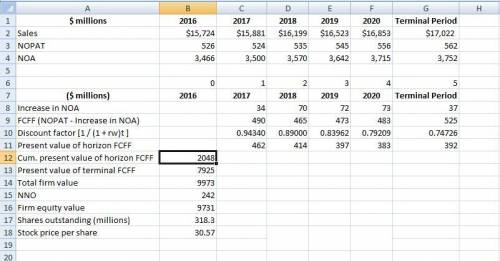
Business, 05.06.2020 16:58 Gearyjames8
Estimating Share Value Using the DCF Model Following are forecasts of Whole Foods sales, net operating profit after tax (NOPAT), and net operating assets (NOA) as of September 25, 2016.
Reported Horizon Period
$ millions 2016 2017 2018 2019 2020 Terminal Period
Sales $15,724 $15,881 $16,199 $16,523 $16,853 $17,022
NOPAT 526 524 535 545 556 562
NOA 3,466 3,500 3,570 3,642 3,715 3,752
Answer the following requirements assuming a discount rate (WACC) of 6%, a terminal period growth rate of 1%, common shares outstanding of 318.3 million, and net nonoperating obligations (NNO) of $242 million.
(a) Estimate the value of a share of Whole Foods' common stock using the discounted cash flow (DCF) model as of September 25, 2016.
Rounding instructions:
Round answers to the nearest whole number unless noted otherwise. Use your rounded answers for subsequent calculations.
Do not use negative signs with any of your answers.
Reported Forecast Horizon
($ millions) 2016 2017 2018 2019 2020 Terminal Period
Increase in NOA Answer Answer Answer Answer Answer
FCFF (NOPAT - Increase in NOA) Answer Answer Answer Answer Answer
Discount factor [1 / (1 + rw)t ] (Round 5 decimal places) Answer Answer Answer Answer
Present value of horizon FCFF Answer Answer Answer Answer
CUMULATIVE present value of horizon FCFF $ Answer
Present value of terminal FCFF Answer
Total firm value Answer NNO Answer
Firm equity value $ Answer
Shares outstanding (millions) Answer (Round one decimal place)
Stock price per share $ Answer (Round two decimal places)
(b) Whole Foods stock closed at $30.96 on November 18, 2016, the date the 10-K was filed with the SEC. How does your valuation estimate compare with this closing price? What do you believe are some reasons for the difference?
A. Stock prices are a function of many factors. It is impossible to speculate on the reasons for the difference.
B. Our stock price estimate is only a few cents lower than the Whole Foods market price, indicating that we believe that Whole Foods stock is accurately priced. Our stock price estimate is lower than the Whole Foods market price, indicating that we believe that Whole Foods stock is overvalued.
C. Stock prices are a function of expected NOPAT and NOA, as well as the WACC discount rate. Our lower stock price estimate might be due to more optimistic forecasts or a lower discount rate compared to other investors' and analysts' model assumptions.
D. Our stock price estimate is lower than the Whole Foods market price, indicating that we believe that Whole Foods stock is undervalued. Stock prices are a function of expected NOPAT and NOA, as well as the WACC discount rate. Our lower stock price estimate might be due to more optimistic forecasts or a lower discount rate compared to other investors' and analysts' model assumptions.

Answers: 3


Another question on Business

Business, 21.06.2019 20:00
Your assessment tool contains rich data about child progress in language and literacy but no details to explain the differences between children. you decide to: a. replace the tool with another b. analyze the data using factors such as language, ability, and participation rates c. review your anecdotal notations regarding language and literacy development d. talk with families about what they are seeing at home
Answers: 2

Business, 22.06.2019 10:40
Two assets have the following expected returns and standard deviations when the risk-free rate is 5%: asset a e(ra) = 18.5% σa = 20% asset b e(rb) = 15% σb = 27% an investor with a risk aversion of a = 3 would find that on a risk-return basis. a. only asset a is acceptable b. only asset b is acceptable c. neither asset a nor asset b is acceptable d. both asset a and asset b are acceptable
Answers: 2

Business, 22.06.2019 20:50
Which of the following statements regarding the southern economy at the end of the nineteenth century is accurate? the south was producing as much cotton as it had before the civil war.
Answers: 3

Business, 22.06.2019 21:10
An investor purchases 500 shares of nevada industries common stock for $22.00 per share today. at t = 1 year, this investor receives a $0.42 per share dividend (which is not reinvested) on the 500 shares and purchases an additional 500 shares for $24.75 per share. at t = 2 years, he receives another $0.42 (not reinvested) per share dividend on 1,000 shares and purchases 600 more shares for $31.25 per share. at t = 3 years, he sells 1,000 of the shares for $35.50 per share and the remaining 600 shares at $36.00 per share, but receives no dividends. assuming no commissions or taxes, the money-weighted rate of return received on this investment is closest to:
Answers: 3
You know the right answer?
Estimating Share Value Using the DCF Model Following are forecasts of Whole Foods sales, net operati...
Questions



Mathematics, 12.08.2020 05:01


Mathematics, 12.08.2020 05:01





Mathematics, 12.08.2020 05:01



Mathematics, 12.08.2020 05:01











